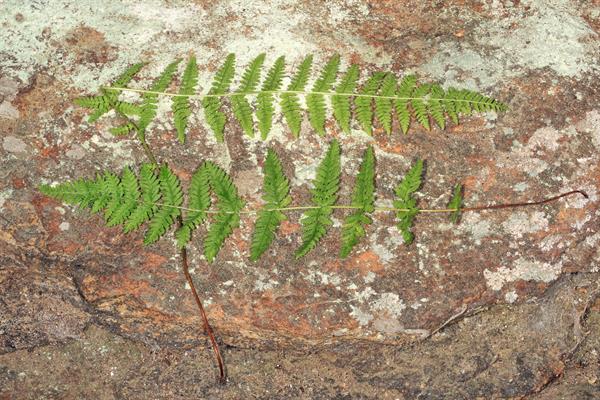Plant Index
Woodsia appalachiana
Woodsia appalachiana T.M.C. Taylor
appalachian cliff fern, appalachian woodsia, mountain woodsia

Image ID: 12810
Image by: Cressler, Alan M.
Image Collection: NCBG Digital Library
PLANT INDEX
ID_PLANT: WOAPSCIENTIFIC NAME: Woodsia appalachiana
Include in WOTAS: 0
Publish to Web: 1
Last Modified: 2020-01-01
GENUS INDEX
GENUS CODE: WOODSGENUS SCIENTIFIC: Woodsia
GENUS AUTHORITY: R. Br.
GENUS COMMON: Cliff fern
GENUS SUMMARY: A genus of about 30-38 species, of temperate and cool-temperate regions, widespread in the Northern Hemisphere, in montane tropical South America and Africa.
GENUS IDENTIFICATION: Identification notes: Woodsia species and Cystopteris species are all small ferns with thin-textured leaves, occurring primarily on or near rock outcrops; they frequently occur together or in proximity to one another and are often confused. Woodsia has the indusium divided into a series of scale-like or hair-like structures, attached below the sorus; Cystopteris has an undivided indusium, pocket-like or hood-like, attached around one side of the sorus. Woodsia has persistent dark petiole bases; in Cystopteris the petiole bases are deciduous. Woodsia has the final veinlets not reaching the margin; Cystopteris veins do reach the margin.
GENUS REFERENCES: Windham in FNA (1993b); Lin, Li, Iwatsuki, & Smith in FoC (2013); Kramer et al. in Kramer & Green (1990).
FAMILY INDEX
FAMILY CODE: WOODSIFAMILY SCIENTIFIC: Woodsiaceae
FAMILY AUTHORITY: Herter 1949
FAMILY COMMON: Woodsia Family
FAMILY SUMMARY: A family of about 15 genera and 700 species, cosmopolitan in distribution, but concentrated in temperate and montane areas.
FAMILY REFERENCE: Smith in FNA (1993b); Smith et al. (2006); Lellinger (1985); Kramer et al. in Kramer & Green (1990).
NCBG DESCRIPTIVES
INTRO:STEMS:
LEAVES:
INFLORESCENCE:
FLOWERS:
FRUITS:
COMMENTS:
HEIGHT:
DURATION: Perennial
HABIT: Herb, Fern
LEAF ARRANGEMENT:
LEAF COMPLEXITY:
LEAF RETENTION:
FLORAL CHARACTERISTICS
SYMMETRY:
BLOOM TIME: Jun-Sep
| Jan | Feb | Mar | Apr | May | Jun | Jul | Aug | Sep | Oct | Nov | Dec |
| x | x | x | x |
BLOOM COLOR:
| White | Red | Pink | Orange | Yellow | Green | Blue | Lavender | Purple | Violet | Brown | Not Applicable |
| x |
FRUITING PERIOD:
DISTRIBUTION
HABITAT TYPE:
NATIVE RANGE:
HORTICULTURAL
Plant Sale Text:
Bloom Table Text:
NCBG Location:
Cultural Notes:
SOIL MOISTURE: Dry, Average
LIGHT EXPOSURE: Sun, Part Shade, Shade
MINIMUM HARDINESS ZONE:
MAXIMUM HARDINESS ZONE:
GERMINATION CODE:
WILDLIFE VALUE:
DEER RESISTANCE:
USDA PLANTS DATABASE
USDA Symbol: WOAPUSDA Common Name: Appalachian Cliff Fern
Native Status: L48 (N)
Distribution: USA (AR, GA, KY, NC, OK, TN, VA, WV)
Duration: Perennial
Growth Habit: Forb/herb
2018 Natural Heritage Program List of Rare Plant Species of North Carolina
| NHP ID | S RANK | ROUNDED S RANK | G RANK | ROUNDED G RANK | STATE STATUS | FEDERAL STATUS |
| 16641 | S2 | S2 | G4 | G4 | SR-P |
WEAKLEY FLORA
SCIENTIFIC NAME: Woodsia appalachianaCOMMON NAME: Appalachian Woodsia, Appalachian Cliff Fern, Mountain Woodsia
SYNONYMY: [= Ar, F, K, Tn, Va; < W. scopulina D.C. Eaton - C, RAB, S, W, WV; = W. scopulina ssp. appalachiana (T.M.C. Taylor) Windham - FNA; = W. scopulina var. appalachiana (T.M.C. Taylor) Morton - G]
PHENOLOGY: Jun-Sep.
HABITAT: On cliffs of sandstone, shale, granite, granitic gneiss, and hornblende gneiss.
COMMENTS: Endemic to the Southern and Central Appalachians of VA, WV, NC, nw. GA, TN, and the Ozarks of AR (Peck 2011). This species is similar to W. scopulina of the western mountains of AK south to CO and CA. The eastern plants have been variously treated as a full species, a subspecies or variety of W. scopulina, or as indistinguishable from W. scopulina (see synonymy). It now appears that W. appalachiana may be a rather cryptic but distinct element of a reticulate complex also involving W. scopulina ssp. scopulina (of the Rocky Mountains) and W. scopulina ssp. laurentiana Windham (primarily of the Rocky Mountains but also disjunct eastward in ON and QC). Windham in FNA (1993b) treats these three entities as subspecies, and suggests that ssp. laurentiana is the allotetraploid derivative of hybridization of the eastern and western diploids. If this is indeed so, each of the 3 entities should be recognized at the species level.
RANGE MAP: Woodsia appalachiana.png

Key to Map Symbols
ABOUT FAMILY (Weakley Flora)
Woodsiaceae Herter 1949 (Woodsia Family)
SUMMARY: A family of about 15 genera and 700 species, cosmopolitan in distribution, but concentrated in temperate and montane areas.
REFERENCE: Smith in FNA (1993b); Smith et al. (2006); Lellinger (1985); Kramer et al. in Kramer & Green (1990).
ABOUT GENUS (Weakley Flora)
Woodsia R. Br. (Cliff fern)
SUMMARY: A genus of about 30-38 species, of temperate and cool-temperate regions, widespread in the Northern Hemisphere, in montane tropical South America and Africa.
REFERENCE: Windham in FNA (1993b); Lin, Li, Iwatsuki, & Smith in FoC (2013); Kramer et al. in Kramer & Green (1990).
HERBARIUM RESOURCES
SERNEC: Find Woodsia appalachiana in Southeast Regional Network of Experts and Collections (if available)UNC SERNEC: Find Woodsia appalachiana in University of North Carolina Chapel Hill Herbarium - Southeast Regional Network of Experts and Collections (if available)
WEB RESOURCES
USDA: Find Woodsia appalachiana in USDA PlantsNPIN: Find Woodsia appalachiana in NPIN Database
FNA: Find Woodsia appalachiana in the Flora of North America (if available)
Google: Search Google for Woodsia appalachiana
IMAGE USE RECORDS
ID IMAGE: 12810 - Primary Image FloraQuest Plant Detail Page (Landscape Preferred)ID IMAGE1: 12810 - Primary Image WOTAS
ID IMAGE2: 0 - Secondary Image WOTAS
ID IMAGE3: 12810 - Primary Image Plant Sale Sign (Landscape Only)
ID IMAGE4: 0 - Primary Image New Plant Sale Label (Portrait Only)
From the Image Gallery
 Image ID: 12811 |
 Image ID: 12812 |
 Image ID: 12813 |
 Image ID: 98798 |
 Image ID: 98799 |
 Image ID: 98800 |